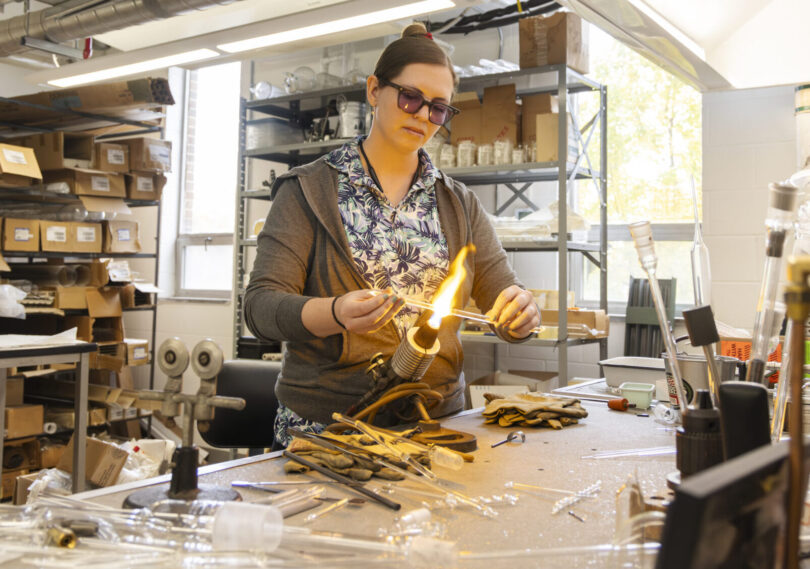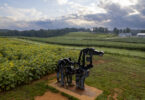The need for glass in research is ubiquitous. Glass holds chemicals and houses reactions, and it’s durable and easy to clean when the experiment’s over. But where does all that glassware come from? At UGA, the Scientific Glass Blowing Shop creates glassware and the everyday essentials scientists and students need all across campus.
It all started with glass beads.
Those unassuming but pretty craft store staples that serve as the foundation of many a homemade necklace.
Annalee Pickett loved the little round pieces of glass, and she found herself making all sorts of trinkets for her family and friends. When Pickett’s high school art club teacher received some unexpected funding, she noticed her students’ interest in the baubles and ordered a kit to make the beads, complete with glass rods and a small torch.
Pickett was hooked. So hooked that she asked her parents for one for Christmas so she could make the baubles at home too.
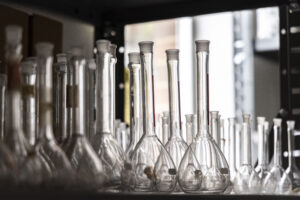
Glassware is essential for the scientific research conducted at UGA. As the manager of the Scientific Glass Blowing Shop, Annalee Pickett helps bring that research to life. (Photo by Elisa Fontanillas)
At the time, the Illinois teenager wasn’t thinking this would be the start of her career. She just thought the glass pieces she created were a beautiful and easy way to create gifts for herself and her loved ones.
But then fate stepped in.
Pickett’s aunt, a hairdresser, cut the hair of Dave Perry, the scientific glassblower at the University of Illinois. He noticed all the glasswork in the studio and asked who made it. When Aunt Bonnie told him, Perry invited Pickett to come to his shop.
“As soon as I went there, I knew that glass was just so much more than art,” Pickett says. “I just loved all the machines, the different kinds of tubing.”
Pickett had found herself a career.
“I’ll never be a scientist, but here, I get to be involved in the science. There’s a need we get to fill, a real, definitive use.” — Annalee Pickett, Manager, UGA Scientific Glass Blowing Shop
Perry’s assistant had gone to Salem Community College in New Jersey, the only school in North America with an accredited scientific glass technology program. Pickett soon followed in his footsteps, graduating from the program in 2011 and immediately heading off to Colorado to join the industry of scientific glassblowers.
In 2020, the University of Georgia came calling.
The previous scientific glassblower had left, and the shop in the Chemistry Building sat empty. Having always respected the community of university-based glassblowers, Pickett took a risk and headed south.
Designing the perfect glass container
Beakers littering tabletops, test tubes filling drawers, and other more specialized glassware holding various chemicals and other substances. Just about every scientific experiment requires something made of glass.
That glassware has to come from somewhere.
While researchers could just order test tubes from a massive production company, often scientists need something custom, created from scratch and blown to precise specifications required to perform a particular task.
That was the case for Tina Salguero, an associate professor of chemistry in the University of Georgia’s Franklin College of Arts and Sciences. Salguero’s lab studies the structure of crystals, analyzing how they could inform the creation of new materials for electronics somewhere down the line.
But first Salguero must grow the crystals. To do that, she needs the right container.
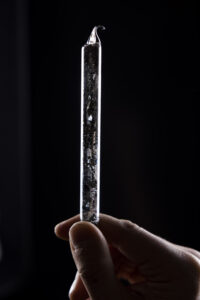
Associate Professor Tina Salguero collaborated with the Glass Blowing Shop to design specialized ampules to grow crystals for her lab to study. (Photo by Peter Frey/UGA)
That’s where Pickett comes in.
“The ampules we use to grow our crystals are all custom-made,” Salguero says. “You can’t buy these, and they are absolutely necessary for our work.”
She worked with UGA’s previous glassblower, Kyle Meyer, to perfect the design of the tubes her lab uses daily.
When Salguero holds up the glass tube, it looks like almost any other tube you’d see in a lab. Except it’s filled with what looks like shards of shiny black glitter. The crystals grow inside the tube, shielding the chemicals from oxygen exposure.
“If we did not have a glassblowing shop, we would not be doing this kind of work,” Salguero says. In fact, many others in her field can’t do what Salguero’s lab does because they don’t have access to a glassblower.
The hidden gem of the sciences
The glass blowing shop is grouped within UGA’s Center for Applied Isotope Studies, originally established in 1977 to advance nuclear technology. Now the center offers a variety of services to faculty, researchers, and students, ranging from food and beverage authenticity testing to radiocarbon dating.
It’s a bit of an adventure to find the shop right now, due to ongoing construction to update the Chemistry Building, but down the winding halls is a space unlike any other on campus.
“The University of Georgia Scientific Glass Shop is truly a hidden gem,” — Carla Hadden, Director, Center of Applied Isotope Studies
Crystal clear tubes several feet long. A bench with a torch fusing two pieces of glass together. A lathe with a flame so hot protective shades are recommended to shield the eyes from the flare when it touches the glass.
“The University of Georgia Scientific Glass Shop is truly a hidden gem,” says Carla Hadden, the center’s director. “We are especially fortunate at the University of Georgia to have a modern, well-equipped, scientific glass shop that is managed by a skilled artisan who is renowned in her field.”
Pickett is the current president of the American Scientific Glassblowers Society, and her enthusiasm for what she does is contagious. So contagious that senior math and management information systems major Kunal Vohra begged to get into her scientific glassblowing class, offered once a year each spring to mostly graduate chemistry majors.
It’s a small course, with only five slots, but as luck would have it, there was one open.
Vohra was in.
Each week, he learned a new skill. Week one: Make a round-bottom tube. Week two: Create a flat-bottomed tube. Week three: Merge the tubes together.
“Annalee would give us a demonstration for a couple examples, show us the process. We would ask questions, and then all of us would fail miserably when we tried to do it,” Vohra laughs. “Then we would come back, and we’d all ask more questions.”
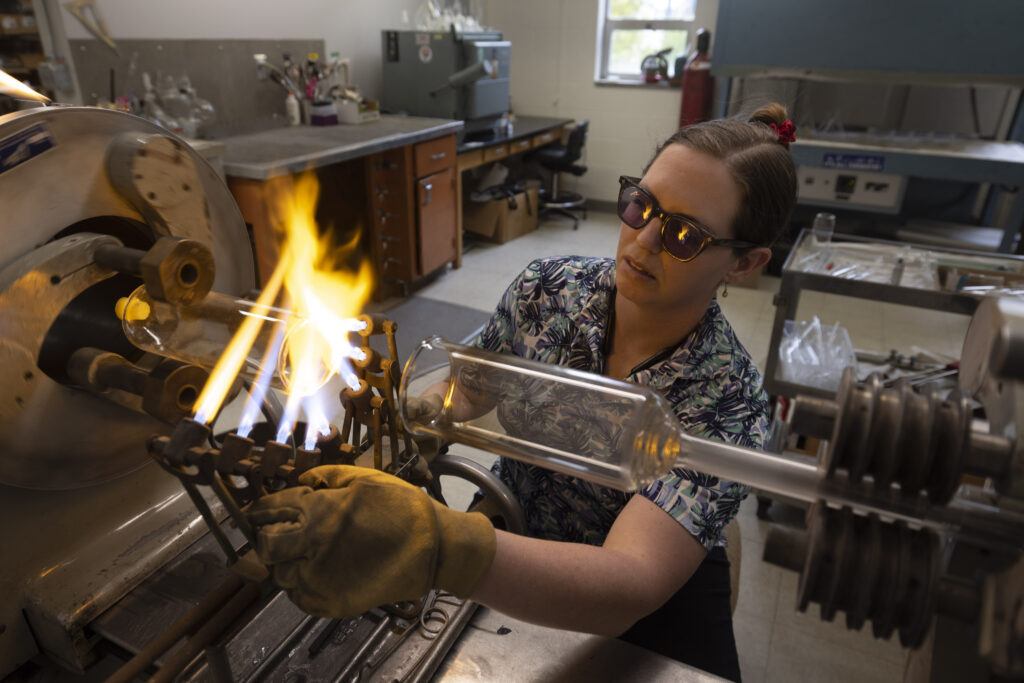
Working with flames hot enough to require protective shades is a standard part of Annalee Pickett’s day at the UGA Scientific Glass Shop. (Photo by Elisa Fontanillas)
Pickett made the techniques look easy, but Vohra and the other students quickly learned they were anything but.
“Why isn’t this working? Where did this crack come from? Why is it uneven? Why is it asymmetric?” Vohra remembers thinking.
But soon enough, he started to get the hang of it. And once the semester was over, Vohra wanted to continue growing in the craft.
So Pickett hired Vohra to assist her with some of her simpler orders, like smaller test tubes and ampules.
Vohra doubts he’ll become a professional glassblowing. However, he can see himself using these skills for more artistic endeavors in the future.
“In this job, I’m learning really relevant things that will help me use glassblowing as an artistic medium,” he says. “The glass shop’s just really, really cool, and I hope in the future there will be room for more people to get involved with it.”
Pickett agrees, which is why she’s hoping to expand the class and open workshops for faculty and staff in the future.
In the meantime, her goal is to keep doing what she loves: working with UGA researchers to make their experiments possible.
“I’ll never be a scientist, but here, I get to be involved in the science,” Pickett says. “There’s a need we get to fill — a real, definitive use.”
Blowing Glass
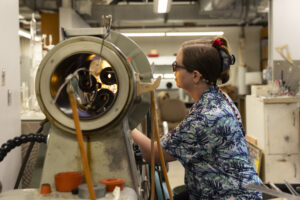
In a modern glass shop, a glassblower often uses a glass lathe – a machine that holds and rotates the glass as the glassblower manipulates the piece. (Photo by Elisa Fontanillas)
An artform that has existed for millennia, traditional glass blowing uses a metal blowpipe to inflate molten glass into a bubble that can then be molded and shaped. The blowpipe resembles a very long straw that runs from the piece of glass to the glassblower’s mouth.
First, the glass is heated in a furnace or over a torch. The ideal temperature depends on the type of glass and the ultimate purpose of the piece and ranges from a little under 1,000 degrees Fahrenheit to over 2,000 degrees.
In a modern glass shop, a glassblower will often use a glass lathe, a machine that holds and rotates the glass as the glassblower manipulates the piece.
The glassblower uses many specialized tools to pinch and pull the glassware into the right shape, all while rotating and continually reheating the glass as needed.
The glassware is then slowly cooled over several hours in a special oven for glass called a kiln to prevent any fracturing.


